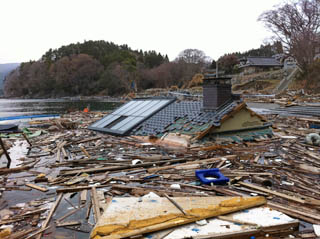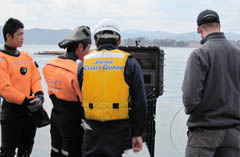

April 28 - Today's guest blog is from Anne Emig, who heads the National Science Foundation office in the U.S. Embassy. The NSF's mission in Tokyo is to strengthen U.S.-Japan scientific exchange, and the office is now bringing that focus to bear in response to the Great East Japan Earthquake.
Jim
Robots to the Rescue

The roof of a house floats among debris in Rikuzentakata after the March tsunami.
The National Science Foundation is funding some disaster recovery/response efforts that will, I believe, soon produce new scientific insights and strengthen U.S.-Japan collaboration. We are funding U.S. researchers to work with Japanese counterparts on rapid response research to gather ephemeral data related to the disaster. Much of this work involves field surveys of earthquake and tsunami impact on the natural and built environment; geotechnical systems performance; critical infrastructure and lifeline systems performance; and disaster preparedness, response and relief.
One of the first of these rapid-response teams just wrapped up its work in Japan. A group of search-and-rescue roboticists led by Dr. Robin Murphy, director of the Center for Robot-Assisted Search and Rescue at Texas A&M University, arrived in Japan on Monday, April 18 to work for a week with Japanese counterparts from the International Rescue Systems Institute.
Murphy was joined by U.S. roboticists from academia and industry: Eric Steimle, Karen Dreger, Jesse Rodocker, and Sean Newsome all donated their time and their robots to the effort through Roboticists Without Borders. Dr. Tetsuya Kimura of International Rescue Systems and Nagaoka Technical University led the effort on the Japanese side.

Coast Guard divers and U.S. team member Jesse Rodocker, right, track images from a robot in waters around Rikuzentakata.
The group worked with local officials in Minami Sanriku-cho, checking port debris levels and searching for victims to enable safe re-opening of the port for local fishing boats. They also worked in Rikuzentakata where they partnered with the Japanese Coast Guard to search for victims beneath heavy surface debris. For more on the mission, see this page (PDF, in Japanese) as well as Murphy's daily blogs.
Another step the NSF is taking in recognition of the far-reaching impact of the disaster on Japan's science and engineering community is to invite U.S. researchers to host displaced Japanese researchers and/or their students in a U.S. lab for up to six months, with the NSF and our counterpart, the Japan Science & Technology Agency, paying the cost. We hope to provide a stable environment for Japanese scientists to continue their research while their facilities and equipment in Japan are restored, and to strengthen U.S.-Japan research collaboration along the way.
While we do not expect a large number of Japanese researchers to take advantage of this opportunity, we hope this program will allow some Japanese researchers and students to continue their work despite the damage to their labs in Japan.
Anne Emig
Dear Mr. Jim Zumwalt,
We, all Japanese, appreciate very much for your whole support about the earthquake on March 11. There are no words but "Thank you so much!" We never forget your heartfelt cooperation of TOMODACHI SAKUSEN. We would like to express lots of thanks to all American people in the world. Thank you very much for saving Japan.